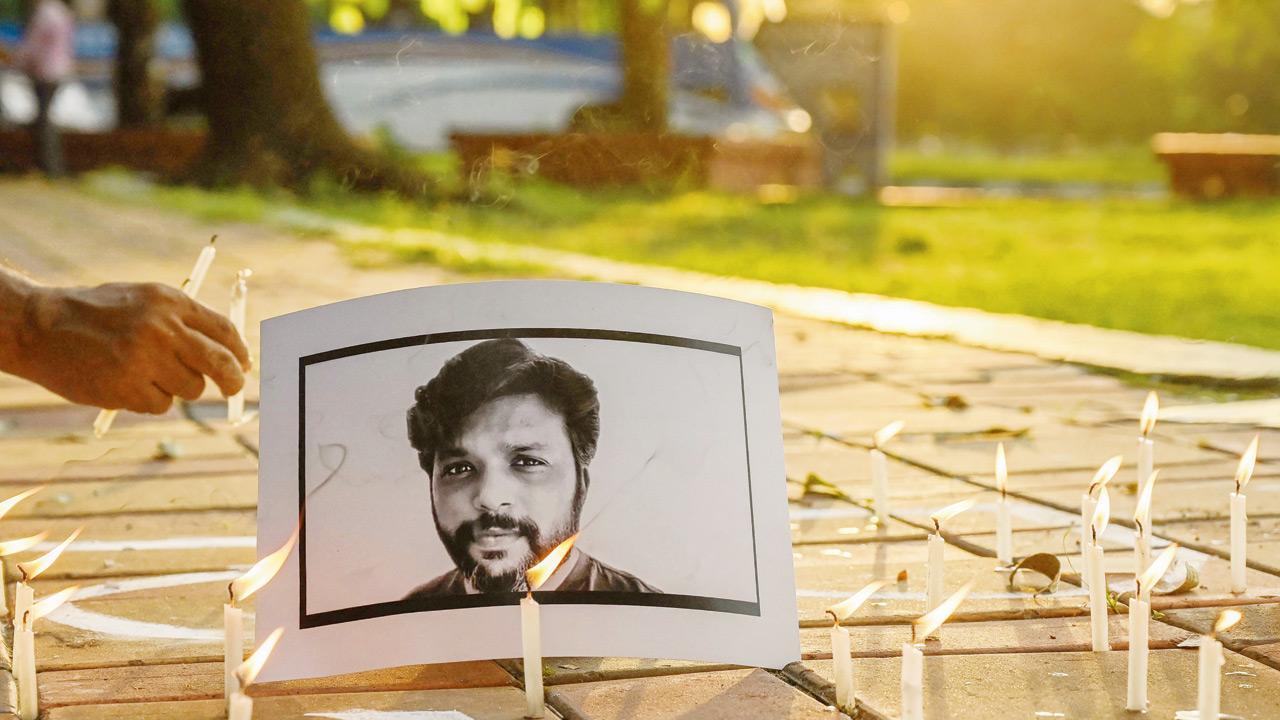Pulitzer winner Danish Siddiqui’s photos covered India like nobody else’s, from life in militarised Kashmir to the plight of the common man during second Covid wave

Journalists in Kolkata pay homage to Danish Siddiqui. Pic/AFP
Award-Winning photojournalist Danish Siddiqui was killed while covering the clashes between Afghan security forces and the Taliban in Kandahar, Afghanistan, on Friday. His father, professor Akhtar Siddiqui, told mid-day that he got to know of Danish’s death from Reuters, where he was employed. “I can’t translate my pain in words,” Akhtar said. Danish’s colleagues said the passionate photojournalist’s pictures always brought forth the human element.
ADVERTISEMENT
He was covering the situation in Kandahar for the past few days. On Friday, Reuters informed me that my son was killed. Then I spoke to the Ministry of External Affairs (MEA), whose officials said the mortal remains will soon be brought to Delhi from the war zone,” Akhtar said. Danish was embedded with the Afghan security forces as part of his assignment.
The eldest of three siblings, Danish was based out of Mumbai until two years ago when he returned to Delhi. He had won the Pulitzer Prize for his work.
Akhtar added, “I last spoke to him the day before yesterday. He loved covering war zones. He used to narrate stories about his work.” Akhtar is a former chairperson of the National Council for Teachers Education and a professor at Jamia Millia Islamia University.
Danish’s colleague from Reuters’s Delhi office, requesting anonymity, said, “It is a huge loss to journalism as he was a Pulitzer Prize winner. He was very passionate about his work.”
The photojournalist completed his BA in Economics from Jamia Millia Islamia University in New Delhi and later studied Mass Communication from AJK Mass Communication and Research Centre at Jamia in 2007.
Danish Siddiqui covered the monsoon floods and landslides of 2013 in Uttarakhand. Pic/AP
He is married to a German national and the couple has two daughters, said his family friends, who thronged to his Delhi residence, Gaffar Manzil near Batla House of south Delhi. “His wife and children were in Germany. They are on their way to Delhi,” Akhtar said.
Danish’s career
TV journalist Aditya Raj Kaul told mid-day that Danish was initially a TV journalist and later became a photographer.
“He joined Reuters as a photographer in 2010 and covered conflicts in Iraq, Afghanistan, Myanmar and other places. He liked his pictures to speak. His work was completely different. His photos would reflect the human element,” said Kaul, who worked with Danish on many national and international assignments. “While covering the pandemic, he gently portrayed the hospital bed crisis and the helplessness of people in his photographs,” Kaul said.
“As a TV journalist, I had gone to cover the Uttarkhand disaster in 2013 when thousands of people had died in the cloudburst. There were many journalists, including Danish, who worked silently and got tremendous pictures,” Kaul said.
“I think he took a lot of risk while covering international war crimes which many journalists may not do,” said Kaul.
Always had a camera
A senior journalist, NB Nair, told mid-day that Danish joined an electronic media house in Delhi as a reporter. “I was an executive producer and he was a TV reporter. I must say he was a reluctant TV reporter as his passion was clicking photographs. He always carried a camera with him,” Nair told mid-day.
“He covered war zones, was a daring and passionate photojournalist with an eye for news. He has clicked tell-tale photographs of the Delhi Riots, the Rohingya crisis, the Covid-19 pandemic, several war zones,” Nair said.
“His pictures, like that of the Delhi crematorium with numerous burning pyres, tell us a lot. During the anti-CAA protest in Delhi, he clicked excellent photographs. We have lost him too soon,” Nair said.
Siddiqui’s neighbour and family friend, Saud Ahmed, said he could not believe it when he heard of Danish’s killing. “He was like a son to me. We have lost him too young. His house is next to mine in Gaffar Manzil but I could not muster the courage to speak to his father. His parents are shattered,” said Ahmed, a former civil servant.
The final assignment
Siddiqui, in his early 40s, was on an assignment covering the clashes in the volatile Kandahar region, as the US withdraws its forces from Afghanistan ahead of the August 31 deadline set by US President Joe Biden.
Afghan special forces had been fighting to retake the main market area of Spin Boldak when Siddiqui and a senior Afghan officer were killed in “Taliban crossfire”, an Afghan commander told Reuters. Reuters President Michael Friedenberg and Editor-in-Chief Alessandra Galloni, in a statement, said they are working with authorities in the region.
Ministry of External Affairs spokesperson Arindam Bagchi said, “Our Ambassador in Kabul is in touch with Afghan authorities. We are keeping his family informed of the developments.”
Afghanistan’s ambassador to India, Farid Mamundzay, said he was deeply disturbed by the news of “the killing of a friend”. “I met him 2 weeks ago before his departure to Kabul. Condolences to his family & Reuters.”
Also Read: Body of Danish Siddiqui handed over by Taliban to Red Cross: Sources
With Agency inputs
 Subscribe today by clicking the link and stay updated with the latest news!" Click here!
Subscribe today by clicking the link and stay updated with the latest news!" Click here!






